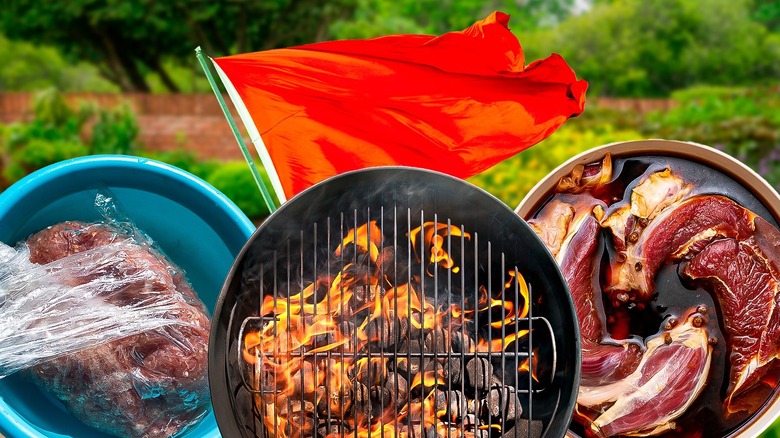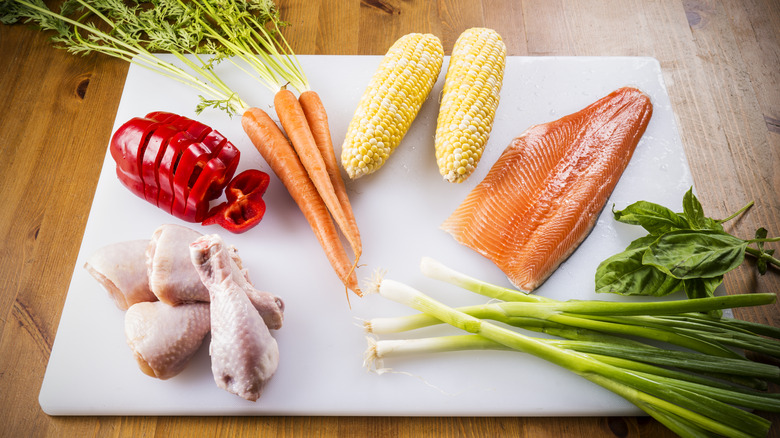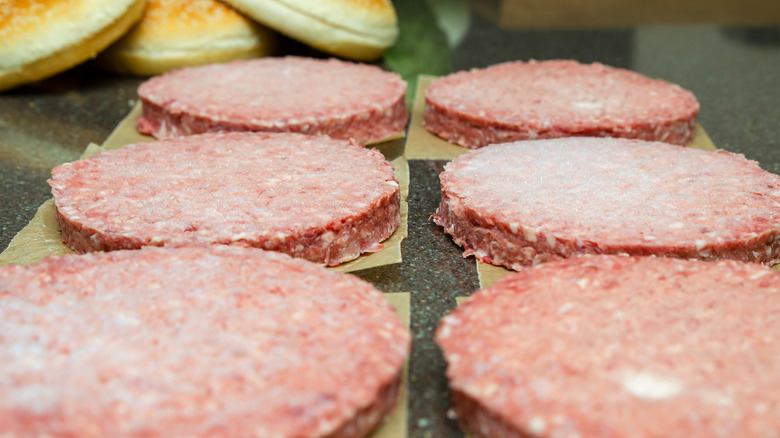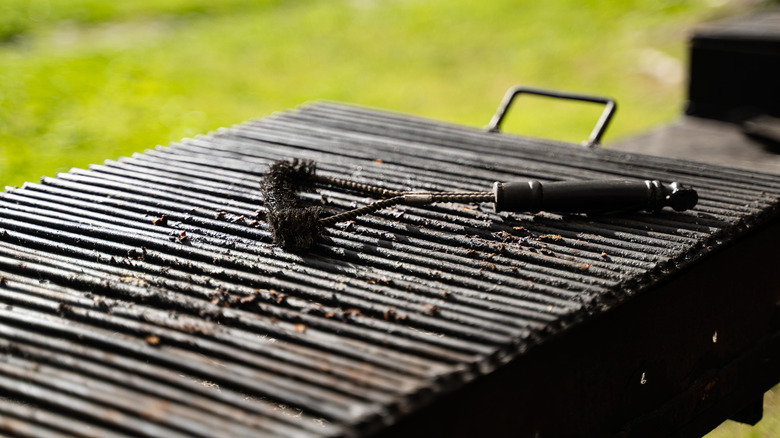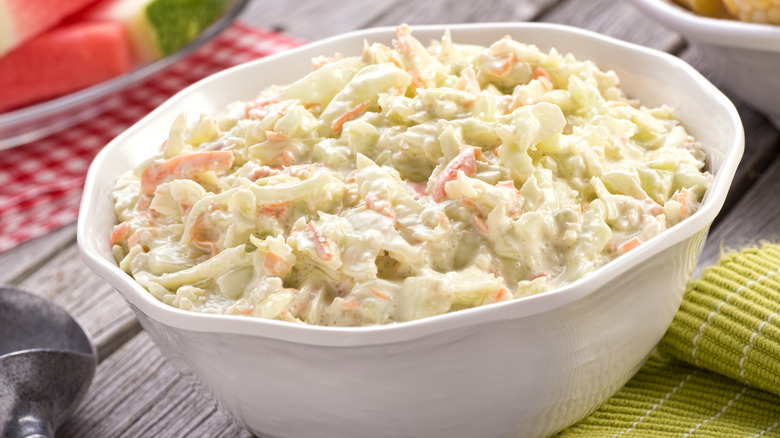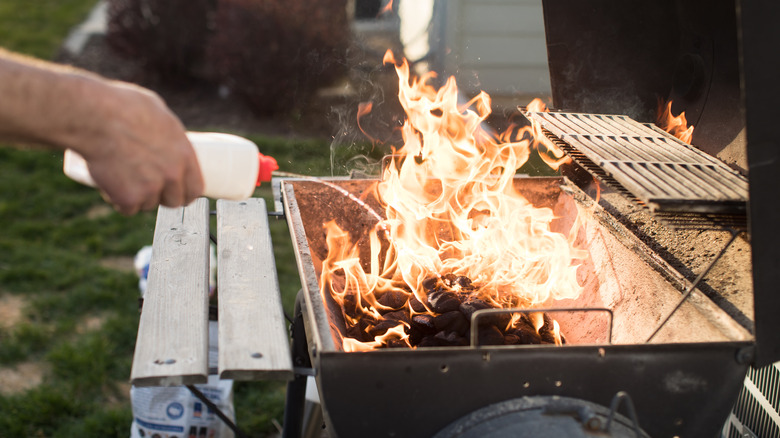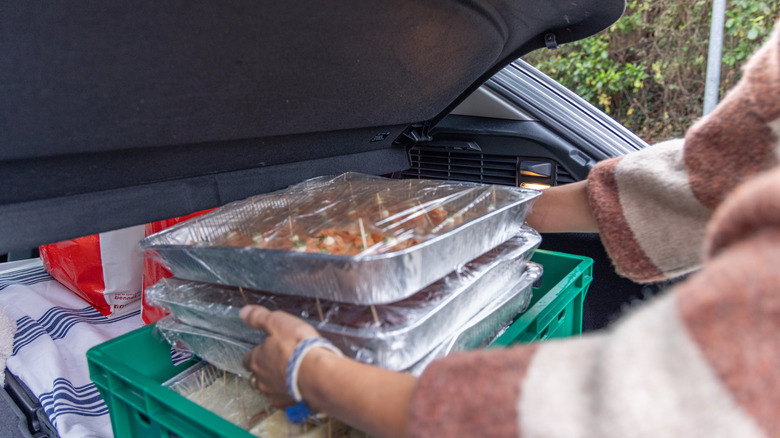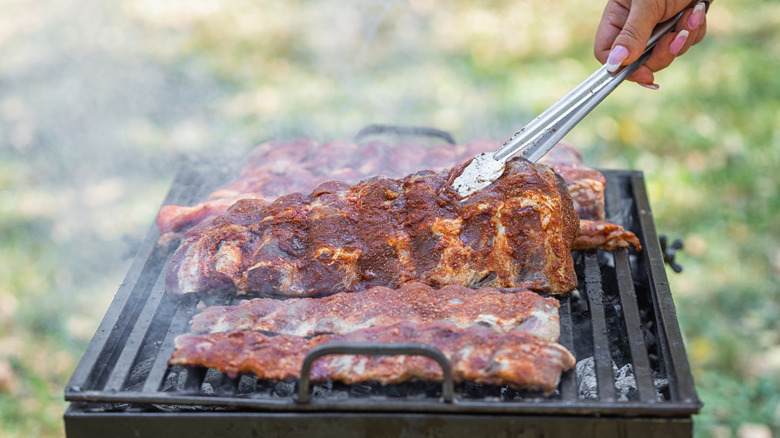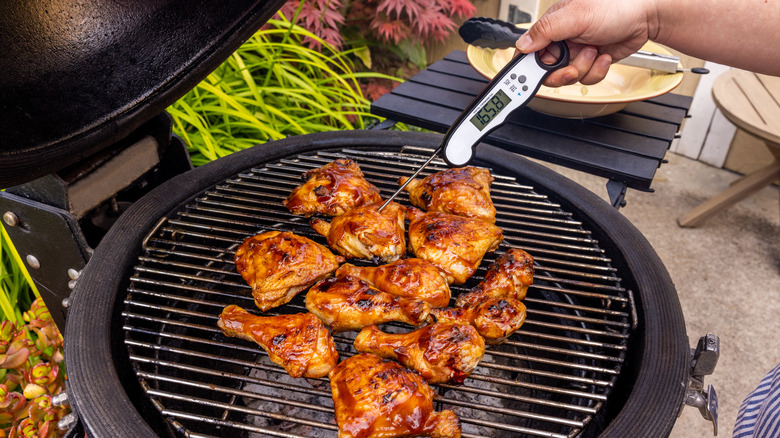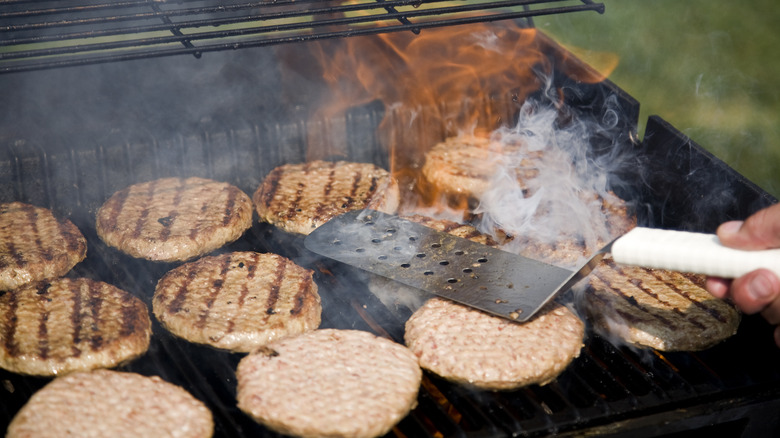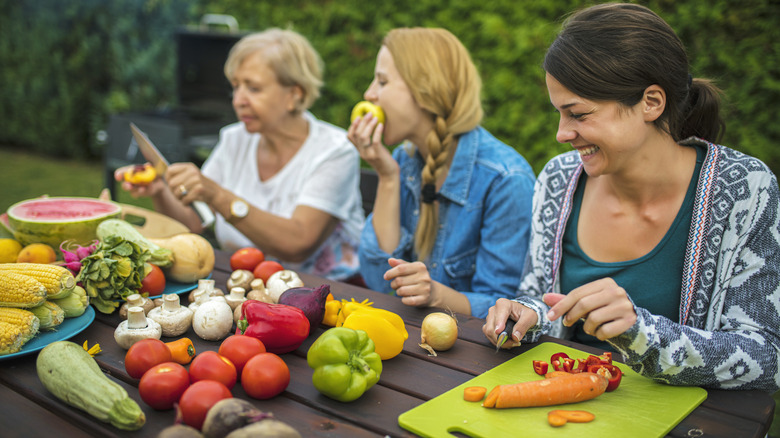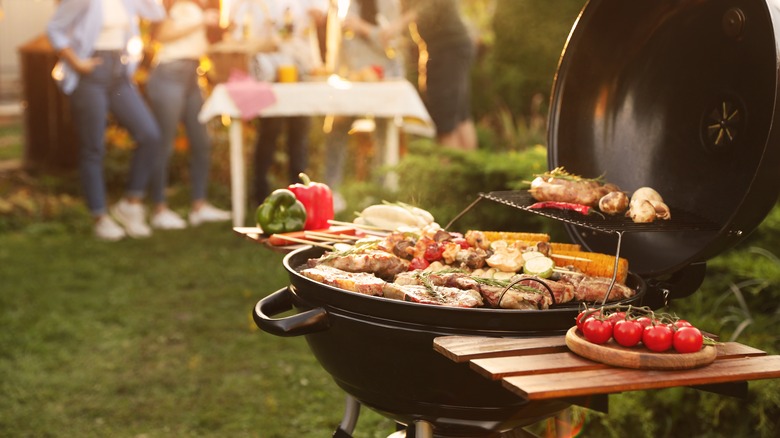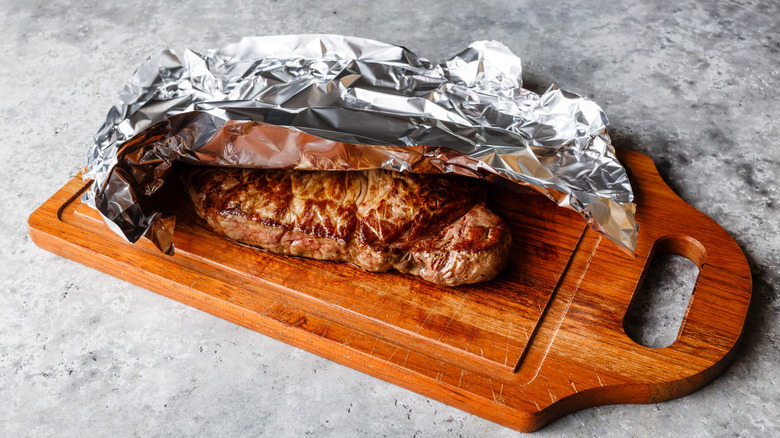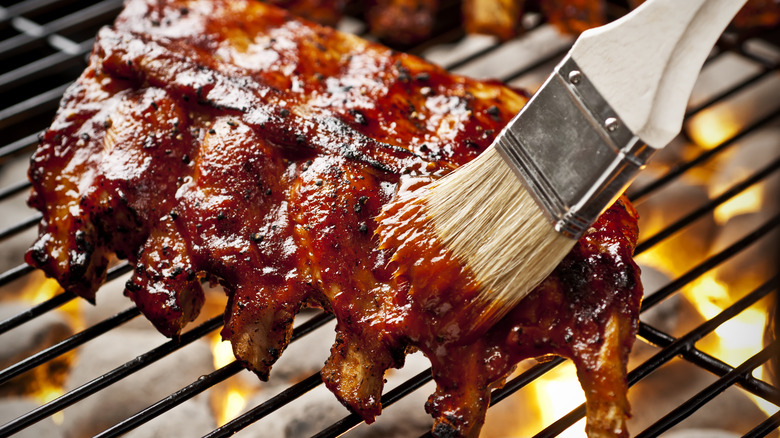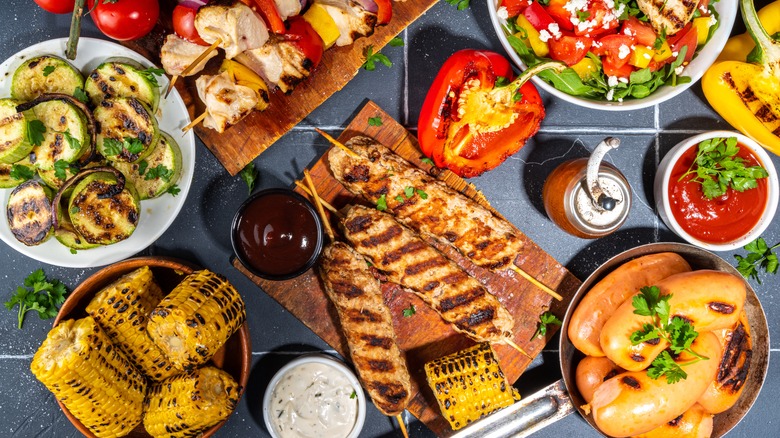14 Red Flags You Should Never Ignore About Foods At A Summer Bbq
Nothing says summer like a backyard barbecue. It's the perfect excuse to gather with your crew outdoors and indulge in some seriously good eats. Think smoky grilled meats, flame-kissed veggies, and an array of side dishes that go so well with barbecue like creamy coleslaw, potato salad, and cornbread. And let's not forget about the desserts. Banana pudding? Ice cream? Yes, please. It can be tempting to dive right into all that cookout cuisine, but before you do, there are some red flags you should be aware of.
Cooking outdoors comes with some unique challenges that make food safety and cooking techniques essential. From the way food is transported and handled to the way it's cooked and presented, there are several missteps that can happen along the way that can ruin the meal. At best, the food may be unappetizing. At worst, it can make you seriously ill. That's why it's important to know some key warning signs that can tell you whether the food you're about to devour is sketchy. If you want to avoid food poisoning and terrible-tasting bites, be sure not to ignore these red flags at your next summer barbecue.
All foods being prepared on one cutting board
Backyard barbecues require a lot of preparation, from chopping vegetables, to cutting meat, and mincing herbs for marinades and seasonings. Cutting boards are crucial to getting those jobs done. Notice we said cutting boards — plural, not singular. If you rock up to a barbecue and see all of the food being prepared on just one chopping board, you can almost guarantee you're in for a world of trouble. That's because of a little thing called cross-contamination.
Cross-contamination happens when bacteria on food are transferred to other foods or surfaces. All foods can contain microorganisms, but the biggest culprits for food-borne bacteria are raw meats. Therefore, it's essential to keep raw chicken, beef, pork, and seafood away from other food items. There should always be separate cutting boards for raw meats, cooked meats, veggies, and foods that aren't going to be cooked like bread and cheeses. In addition, cutting boards should be thoroughly cleaned with hot water and soap after every use to prevent bacteria from multiplying. If your barbecue host doesn't follow these practices, you may want to think twice about accepting that burger or kebab.
Meats being defrosted on a counter or outdoors
With all the hustle and bustle of a barbecue going on, who has time to worry about thawing meat? So many people slap their frozen wings, patties, or ribs on the counter or picnic table and let nature do its work. Others try to speed up the process by running the meat under hot water. Many don't realize that those are actually some of the absolute worst ways to thaw meat because they could make you incredibly sick.
Frozen meat is safe while it's still in its frozen state, but once it starts to thaw, bacteria that may have been on the food before can begin to multiply. The USDA states that the "danger zone" for bacteria multiplying is between 40 degrees and 140 degrees. Therefore, the safest way to thaw meat is in the refrigerator overnight at a constant state of 40 degrees or below. In a pinch, cold water can speed things along. In that case, the meat should be wrapped up tightly in plastic or some other waterproof packaging to prevent water from getting in. The microwave is another option for quick defrosting. Once the meat has thawed, it should be cooked immediately to destroy any lingering bacteria. It is also safe to cook meat from frozen.
Foods cooked on a dirty grill
One of the downsides of owning a grill is how time-consuming and onerous it can be to clean all the components. It's a task that many people put off for as long as possible until the grease and gunk become too gross to ignore. Some people point to the fact that a grill is essentially self-cleaning because the flames burn off bacteria. Unfortunately, that's simply not true. A dirty grill can most definitely harbor harmful bacteria. And that's only one of the reasons you shouldn't eat foods that have been cooked on a grill that hasn't been properly cleaned.
When meat is cooked at high temperatures, chemical reactions can cause carcinogens to form. They can get left behind on the grill, along with bits of meat, fat, and marinade. If a grill hasn't been cleaned properly, bacteria and carcinogens can transfer to new food through direct contact with the grill surfaces or smoke. In addition, grease and grime can prevent a grill from cooking foods evenly and to the correct temperature. Add to that the possibility of mold growth or droppings from rodents or insects and you have a pretty solid case for turning down food that's been cooked on a filthy grill.
Creamy salads sitting in the sun
What summer barbecue is complete without a creamy salad or two? Mayonnaise-based sides like coleslaw, potato salad, and macaroni salad are meant to be cool and refreshing, providing the perfect complement to smoky meats hot off the grill. The only problem is those salads can be ticking bacteria bombs. Mayonnaise is made from eggs, so it needs to be kept cool to prevent spoiling. In addition, the vegetables in the salads can also harbor pathogens. Same goes for additions like eggs, meats, or cheese. The longer the salads sit out on a hot day, the more chances there are for the microorganisms to spread.
The best way to prevent these dishes from spoiling at a barbecue is to keep them in a refrigerator or cooler until they're ready to be served. Setting them in a bowl of ice and covering them can also keep them cool. Be wary of any creamy salad, dessert, or condiment that's been sitting out for more than an hour. That's about the amount of time it takes for them to reach the "danger zone" of 40 degrees. That window shortens significantly if you factor in direct sunlight.
Foods cooked on a grill lit with lighter fluid
There are several key differences between gas and charcoal grills, the main one being that the latter gives you a smoky flavor you just won't get from a gas grill. However, charcoal grills can be tricky to light. To solve that problem, many people douse their coals in lighter fluid and start a raging inferno to get them glowing in lightening fast time. Not only is this a major fire hazard, but it can also affect the taste of the food.
Lighter fluid is typically made with either alcohol or petroleum and it can contain some pretty nasty substances that can be harmful to your health. While the fluid itself will eventually burn off, thus reducing the risk of health complications, the lingering fumes can impart highly unpleasant gas-like flavors to food cooked over the coals. If you're wondering why your grilled meat tastes funny at a barbecue, it could be because the person in charge of the 'cue has a penchant for liquid fire starter.
Foods transported in the trunk of a car
It's pretty common for barbecue guests to bring a dish or two of their own to add to the spread. If you're planning on bringing prepared food to a barbecue, know that you should never place it in the trunk of your car. It typically has less air flow than the rest of the car, so it can get incredibly hot on days when the temperature outside is soaring. Any food inside the trunk can heat up quickly, allowing bacteria to run rampant.
When transporting food, use enclosed containers and keep the food at safe temperatures. Cold foods should be transported in a cooler or on ice. Hot foods should be insulated to keep the heat in or be kept in a warmer box. Carry the food in the main body of the car and out of direct sunlight if possible. For cold foods, use the air conditioning to keep the temperature consistently cool or roll down the windows for better air flow.
The same utensils being used for cooked and raw meat
Most people are aware that raw meat and cooked meat should never sit together on the same plate. However, many people don't think twice about using the same tongs or spatula to place raw meat on the grill, flip it, and then toss it onto a serving platter or bun when it's done. It's one of the most common grilling mistakes people make, and one that can potentially wreak havoc on your health. Once again, it comes down to cross-contamination.
One way you can tell your barbecue host is serious about avoiding cross-contamination is if they have two sets of utensils — one for raw meat and one for cooked meat. The first set of utensils should be used to place the raw meat on the grill and do the first few turns or flips. Once it is mostly cooked through, the second set of utensils should be used to finish up on the grill and place it on a clean platter or plate. In addition, serving utensils should never come into contact with raw or partially cooked meat.
Meats not cooked to the proper temperature
There's nothing more off-putting than biting into a piece of grilled meat that's raw in the middle. Not only is it unappetizing, but it can give you a nasty case of food poisoning. Then there's the flip side — meat that's been cooked so long on the grill that it's been burnt to a crisp. Many barbecue cooks will tell you they know their way around the grill and have their temperatures down pat. In actuality, the only way to truly know if meat is cooked to the right temperature is by using a meat thermometer.
It reads the internal temperature of meats, which is key when cooking on a grill because the searing and grilling can make it look done on the outside when it's not actually safe to eat yet. The USDA recommends cooking poultry, including ground chicken and turkey, to 165 degrees. Other ground meats should be cooked to 160 degrees, and other cuts of meat should be cooked to 145 degrees. While steaks can be served rare, burgers should always be cooked through. This is because E. coli can be transferred from the surface of the meat to the interior in the grinding process.
Burgers that have been pressed down on the grill
Burgers may seem like they're one of the easiest things to grill. After all, how hard is it to slap one on the barbecue, flip it a few times, and serve it up? The truth is there are many mistakes people make when cooking burgers that can result in a disappointing piece of meat. One red flag that it may not be the best version it can be is if the cook presses down on the meat patties while they're on the grill.
There's something so satisfying about squashing a burger with a spatula, hearing the sizzle of fats, and seeing flames flare up. Yet, those fats are part of what makes this creation taste so good. Smashing the burgers on a grill releases those tasty juices that also keep the burger moist. Once they're gone, the patty will most likely be flat, dry, and flavorless. In addition, the burgers will be more likely to stick to the grill and create a mess. The golden rule for juicy, grilled burgers is to just let them be. A flip or two is fine, but smashing is a no-go.
Fruits and vegetables that haven't been washed
When it comes to barbecue food safety, meats are typically the main concern. While it's true that animal products are more likely to cause food poisoning than many other types of foods, that doesn't mean produce is in the clear. Fruits and vegetables can also contain harmful bacteria like E. coli, salmonella, and listeria. Plus, you never know what those fruits and vegetables came into contact with before they made their way to you. Before you bite into a peach or pile your plate with salad at a barbecue, be sure those fruits and veggies have been washed properly.
Fruits and vegetables should be thoroughly washed with cold water to remove dirt, bacteria, and fungus. This includes items with inedible skins, peels, or rinds. The reason for this is bacteria on the outside of the fruit or vegetable can be transferred to the edible part when you cut through the skin. Hard and bumpy items can be gently scrubbed to get into all the cracks and grooves. Produce should be dried after it's washed and chopped on a clean cutting board separate from cooked and raw meats.
Foods cooked on an overcrowded grill
Summer barbecues scream abundance, from platters piled high with meats to picnic tables loaded with tempting salads and snacks. There's one place where it pays to have a little restraint though and that's on the grill. Cooks may be tempted to load it up with as much food as possible to get the feed on faster, but that's a big mistake. If you see an overcrowded barbecue at a social gathering, you can almost guarantee the food is going to be less than spectacular.
There are a few reasons why it's important not to pile everything on the grill at the same time. First, charcoal and flames need oxygen to create enough heat to cook the items on the grill. Leaving some space on the grates allows air to flow in. Second, different foods require varying levels of heat and cook at different speeds. Staggering the grilling can help ensure everything is cooked properly. Then there is our old nemesis — cross-contamination. Raw foods should never be pressed up against partially cooked foods on the grill. It's better to cook one round of food thoroughly and remove it from the grill before starting on the next.
Meat that hasn't been rested
It's the moment everyone has been waiting for — the meat is fresh off the grill and sitting there in all its glistening glory. The first thing many people want to do is dig right in. That would be another barbecue fail though because most meats need to rest first. The reason it's so important to let meat rest is all of the hot liquids need time to reintegrate back into the meat. If it is cut too soon after being removed from the heat, the juices will seep out and the meat will be dry and lacking flavor.
The resting rule applies to most cuts of meat, including roasts, chops, and steaks. The amount of resting time depends on the type and size of the meat. Smaller items like steaks and chops may only need to rest for 10 to 15 minutes, while larger items like roast turkey can use a good 30 minutes. Tougher cuts of meat like brisket and pork butt can benefit from resting up to a few hours, provided they're kept in an insulated container or warming box.
Foods slathered in reused meat marinade
A tasty marinade can take barbecued foods from boring to brilliant. Marinades are sauces that you bathe meats in prior to cooking them. The juices and spices not only infuse flavor into the meat, they can also help tenderize it, which results in a better mouthfeel and juicier end product. It makes sense then that leftover marinade would make a great sauce for the finished meat. There's a catch though. Under no circumstances should you eat anything sauced in leftover marinade that recently contained raw meat.
A blend that has had raw meat sitting in it has the potential to contain bacteria. Therefore, it should never be used as a sauce for cooked meat unless it's been boiled for at least five minutes first. Boiling will destroy the bacteria, although it may also change the consistency and flavor of the marinade. If you want to use it in its original form as a sauce later, consider setting aside some of the mixture before you put raw meat into it. You may also want to consider making extra marinade just for the cooked meat.
Foods left sitting out for more than an hour or two
One of the biggest questions people have about barbecue foods is how long they can sit outside before they're considered unsafe to eat. The answer depends on the type of fare and the temperature outside. For foods that contain animal products or perishable ingredients, the FDA says two hours is the maximum amount of time they should sit outside. If the temperature outdoors is above 90 degrees, the meal should really only sit out for about an hour. Dry foods like chips, crackers, and breads are fine to stay out longer.
It's easy to lose track of time when you're having fun with friends and family at a barbecue. If you notice that the time has slipped away and food is still sitting out, it's best to discard any leftover meats, salads, and cooked dishes. It seems like a shame to throw away good food, but it's better than risking a potentially life-threatening illness. One way to get around this is to bring a cooler to store food in while it's not being served. Just be sure to replenish the ice packs or ice to make sure it stays at a safe, stable temperature.
